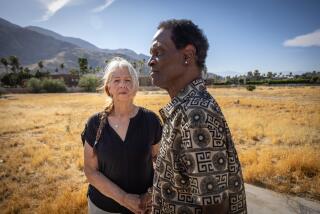ATTACK ON AMTRAK : Sons of Gestapo? They’re Just Nowhere to Be Found : Militants: People in trailer parks and swinging-door saloons are skeptical. They say group could be pranksters or government operatives.
- Share via
NOWHERE, Ariz. — Across the dusty backroads peppered with prickly cacti, in rust-colored towns of trailer parks and antique dealers and swinging-door saloons, there was widespread skepticism Tuesday that the Sons of Gestapo had made a home in this terrain, or that such a group even exists.
Never heard of them. Don’t believe it. Not a chance. “Reminds me of a cheap hooker--wearing loud colors to get recognition,” said Chris Chaney, a 46-year-old real estate broker, who lives in a log cabin in Wilhoit, about 100 miles north of Phoenix. “It’s somebody small trying to sound like somebody big.”
Never mind that a manifesto bearing the cryptic moniker was left behind at Monday’s deadly train derailment. Folks in the Arizona desert have their own theories about the culprits, speculating that they could be anyone from teen-age pranksters to government operatives--but almost certainly not a bona fide paramilitary organization.
“Sons of the Gestapo, my behind,” Barry Young told listeners of his morning talk show on KFYI-AM. “I don’t buy it, ladies and gentlemen.”
Between Young, his guests and his callers, nearly a dozen different scenarios were concocted. Could have been some good ol’ boys out drinking and making mischief. Or a left-wing group out to discredit the militia movement. Or even covert intelligence agents trying to create enough chaos to win congressional approval for the stalled counter-terrorism bill.
“When all is said and done, I think that you’ll find that what we have here is nothing more than vandals,” said Young, adding that he believes the swastika-laced note was purposely left “in order to foul up law enforcement.”
In Black Canyon City, an old mining town surrounded by rocky buttes, Leonard Hall had no doubt that the manifesto was a decoy. “What better way to lay something on somebody else?” said the World War II veteran, a retired carpenter from Anaheim.
As he picked up his mail at the village post office--there is no home delivery in the tiny community--Hall’s imagination was drawn to a racially motivated explanation for the sabotage, which he attributed to anger by white supremacists over O.J. Simpson’s recent acquittal.
“Everything that happens from now on is connected to O.J.,” said Hall, 75, who was wearing a baseball cap that features farm animals in flagrante delicto and the motto: “Barnyard Romance.”
Hall was soon joined by Larry Capasso, a former horse trainer and harness jockey from Upstate New York, who is listed in the Guinness Book of World Records as one of the world’s fastest draws. To allay any doubts, he dug up a copy of the 1978 edition and, on page 626, pointed out his award-winning feat: hitting a man-sized target with live ammunition at 50 yards in 35/100th of a second.
“I’m far, far, far, far, far from the left,” said Capasso, 60, who now raises cattle. “But you don’t destroy your own kind.”
Throughout the Grand Canyon State, an odd sort of duality permeated conversations about the disaster. On one hand, residents spoke movingly about the natural beauty and isolation that marks this part of the country--home to a “a simpler, old-fashioned, slower pace of life,” as Dutch Van Orman put it.
“It’s still cowboy days out here--that’s the appeal of Arizona,” said Van Orman, 43, the resident caretaker of the American Legion hall in Humboldt, as he dragged on a cigarette and sipped coffee Tuesday morning. “It’s the last place where a man can still be a man, where a handshake’s still a handshake and his word’s still his word.”
But Van Orman, a retired police officer from New York, acknowledged that the solitude he finds so calming could also prove attractive to right-wing, paramilitary extremists, who want to be left alone for a whole different set of reasons.
“This is a big, barren country here,” he said. “You’re still living in the Wild West. I can take you over some of these hills and it’s like the 1800s. There could be some encampments where they could be dynamiting or messing with bombs, and you’d never even know it.”
For the regulars at the Burro Inn, located right in the heart of Nowhere (pop. 21), that was an unsettling thought.
“Too many things is happening in our little part of the world,” said Edna Flanigan, as she sipped a cool drink at the old wooden bar. “We just don’t need no more population.”
More to Read
Sign up for Essential California
The most important California stories and recommendations in your inbox every morning.
You may occasionally receive promotional content from the Los Angeles Times.










